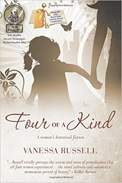
 |
Beginning with the delightful hesitant voice of 82-year-old Ruby, we are invited to share her inability to understand the death of her great-granddaughter Jesi. This happens in a first chapter set at Jesi's funeral in 1964 before the reader is sent to December 1963, a point four months earlier, when four generations of women sit down to write about their "year of awakening." Ruby's story starts along the path of women's suffrage, a cause started but not fully followed through on. From Ruby, the story passes down to her daughter Bess, as she takes up her mother's cause as her own. This, of course, affects the development of Katy as she drifts through the currents of her elders and passes down finally to Jesi.
Each woman in the story has her own unique voice, well-shaped by her age and the experiences she's been through. It isn't just the history of each woman that shapes her narrative though. It is possible to feel the joy in Ruby, the bitterness in Bess, the confusion and lack of direction for Katy, and the disengagement of Jesi as she strives to create her own space among all these women. While it isn't unique to find a book covering a span of generations such as this, it is a testament of the care that went into its production that each woman has such a clear and unique means of expression. As each woman explores her own "year of awakening," secrets are revealed both to the other generations as well as to the women who lived through the experience. A lengthy read, the story nevertheless stands as a symbol of the strength, resilience, and vulnerabilities of women and their fight for dignity and self-respect in a world determined to own them.
RECOMMENDED by the US Review